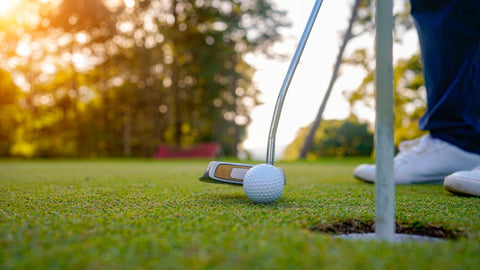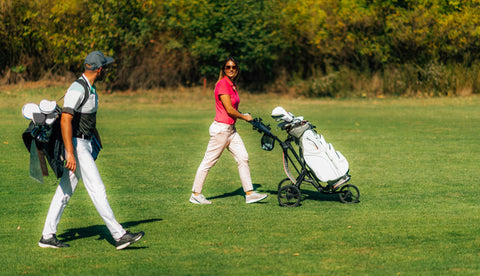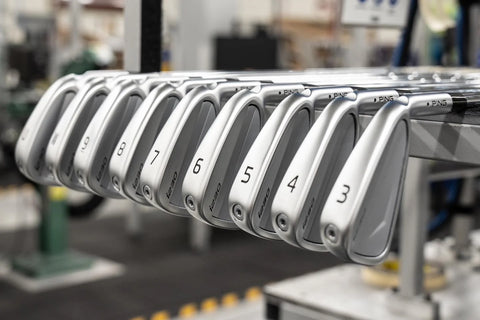
“Drive for show, putt for dough,” as the saying goes. It’s no secret that the putter is the most used club in your bag, and sinking more putts can shave strokes off your entire game. But with so many options on the market, choosing the right putter can feel overwhelming. Fear not, fellow golfer! This guide dives deep into the world of putters, helping you find the perfect match for your putting style and needs.
Putter Types
Blade: The classic choice, blade putters are known for their compact head size and cavity back design. While they offer less forgiveness on off-centre hits compared to mallets, many golfers value the superior feel and control blades provide. They’re a great option for golfers who favour a putting stroke with more arcing motion.
Shop blade putters:
Mallet: With the largest club heads on the market, many mallet putters boast a face-balanced design. This means the clubhead weight is evenly distributed, helping it stay square to your target line throughout your entire putting motion. This stability and extra forgiveness is a huge advantage for golfers with a straight back-and-forth putting stroke.
Shop mallet putters:

Mid-mallet: As the name implies, mid-mallet putters bridge the gap between blade and mallet putters. They offer a mid-sized head that’s thinner than a mallet for a better feel, yet more forgiving on off-centre hits than a blade. The sweet spot is where mid-mallets truly shine. They come in a variety of designs, blending face balance (ideal for straight putting strokes) and toe hang (better for strokes with some arc). This allows you to find a putter that perfectly complements your putting style, particularly if you have an arched backswing but a straighter follow-through.
Shop mid-mallet putters:
What about the face of your putter?
Milled vs. Insert

Milled putters: These putters are crafted from a single block of metal, precision-milled for a rock-solid feel and unmatched consistency. The grooves are meticulously carved, ensuring optimal spin on the ball for a true roll and reliable distance control. If you like a putter that talks back, giving you clear feedback on every putt, a milled putter might be your perfect putting partner.
Insert putters: These putters have a softer insert, usually made of urethane, elastomer, or polymer, nestled right in the face. This insert acts like a shock absorber, dampening vibrations on impact and spreading the ‘sweet spot’ over a larger area. Translation: more forgiveness on off-centre hits and more consistent rolls for putters who crave a little extra help finding the back of the cup.
When choosing a putter, putter balance is a key factor to consider. There are two main types…
Toe Hang vs. Face-Balanced
Face-Balanced: As the name suggests, the clubhead naturally wants to stay square to your target line throughout your stroke. This is ideal for golfers with a straight putting motion. Mallet and mid-mallet putters often fall into this category.
Toe Hang: These putters have more weight in the toe, causing the head to hang slightly downward when balanced on your finger. This design helps players with an arced putting stroke by rotating the face square at impact for better accuracy. Blade putters are more likely to have toe hang.

Match club balance to your unique putting stroke…
What’s your stroke?
Knowing your putting stroke style is an important component in choosing a putter. This will help you be more consistent on the green and sink more putts.
Arc stroke: Unlike a straight back-and-forth stroke, you set up with your eyes slightly inside the ball and behind it. The key difference? Instead of a straight putting path, the putter face opens slightly on the takeaway (bringing the club back) and closes through impact, creating a gentle arc. Some people believe that the arcing motion offers more control over pace and direction.
Straight-through stroke: The eyes of players who putt straight through land directly over the ball. For this style of putting, if you set up a putting line, the sweet spot on the head should follow the line and hit the ball at a 90-degree angle. Your follow-through should also move along a straight course.
A strong stroke starts with the perfect grip…
What about Grip?
Just as with the other clubs in your bag, there are many choices for your putter grip. Finding the right fit maximises your feel for the ball at impact, leading to more confident and consistent putting.
Larger Grip Size: A larger grip encourages a more stable hand position, minimising unwanted wrist movement during your putting stroke. This can lead to greater consistency and accuracy. A larger grip also adds weight to your hands, potentially counterbalancing a lighter putter head. This can improve the putting feel for some golfers, but others might need to adjust the putter weight for optimal balance.
Smaller Grip Size: A smaller grip size enables more precise hand movements, giving you greater control over your putting stroke and improving your feel for the ball at impact. This is ideal for golfers who prefer a hands-on putting style. The lighter weight of a smaller grip can help some golfers achieve a better sense of balance with their putter head, depending on their personal preference.

Golf Putter FAQ
What length should my putter be?
While standard putters for men fall between 33” – 35” and women’s are typically 33”-34”. Don’t get stuck on the numbers. Your ideal putter length depends on your height, arm reach, and putting style. Experiment to find what feels most comfortable and helps you sink those putts.
What’s the best material for a putter?
Stainless steel is the most common since it is durable and has a solid feel. For a lightweight putter, aluminium or titanium are great choices. A brass putter will have a heavier weight. The sound and feel of each material will vary, so experiment to find what suits your stroke.
How much should I budget for a new putter?
You should consider your experience level, how often you play, and your overall budget for clubs. If you are an experienced golfer who plays regularly, you’ll probably want to spend a bit more on your putter to get exactly the right setup for yourself. However, if you’re new to the game and only play a few times a month, you might consider a less expensive putter to start as you will most likely upgrade in the future as your golf game improves.
Which putters do most pros use?
Professional golfers have traditionally favoured blade putters. These offer a direct feel and a toe-weighted design that can be beneficial for players with an arced putting stroke. However, the trend is shifting towards mallet putters. These offer more forgiveness on off-centre hits, which appeals to many golfers. Additionally, some mallet putters with shorter hosels can still promote an arc in the stroke, making them a versatile option.
What is the best brand of putter?
Numerous brands offer excellent putters, so finding the perfect match involves testing different options to see what works best for you. Ultimately, the best putter is the one that helps you sink the most putts, regardless of the brand name.
Shop our full range of golf putters.

Get Fitted for Putting Success
While this guide serves as a valuable resource, there’s no substitute for getting fitted for a putter. A professional fitting allows you to test various putter types, head sizes, lengths, and lie angles in a controlled environment. Our golf pros will analyse your putting stroke and recommend putters that best suit your posture, swing path, and feel preferences.
Investing in a proper putter fitting can significantly improve your putting performance and save you money in the long run. You’ll avoid the trial-and-error of buying putters that might not suit your game, and ultimately find the putter that becomes your “perfect putting partner.”
Putting Perfection Awaits
Choosing the right putter is a personal journey. By understanding the different options available, considering your putting style, and prioritising feel and confidence, you’ll be well on your way to becoming a putting pro. Remember, the best putter is the one that helps you sink the most putts! Visit Golf 360 for all your putting needs.




